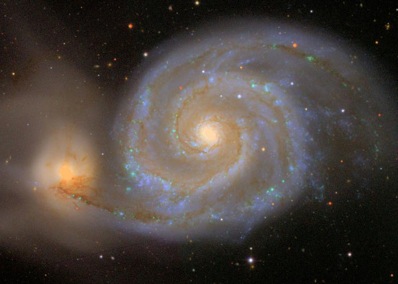|

Top Stories

|

|
 |
 |



Stars born in
galactic centre
...Stars have been seen being born in the inner sanctum of our Milky Way Galaxy, answering the question of whether stars can form there or instead have to migrate there...
read more

The black cloud set to blossom into a giant star
...A freezing cold, dark cloud of molecular hydrogen is beginning to stir up the materials for building a giant star, or even several massive stars, in a forbidding region of the Milky Way known as the Aquila Rift...
read more

Planet-forming disc found orbiting twin suns
...Images collected with the Smithsonian's Submillimeter Array (SMA) radio telescope system reveal the presence of a molecular disc orbiting a young binary star system...
read more |
 |
 |

|
Spaceflight Now +

|

|
 |
 |

Subscribe to Spaceflight Now Plus for access to our extensive video collections!
 How do I sign up? How do I sign up?
 Video archive Video archive

STS-120 day 2 highlights

Flight Day 2 of Discovery's mission focused on heat shield inspections. This movie shows the day's highlights.

 Play Play

STS-120 day 1 highlights

The highlights from shuttle Discovery's launch day are packaged into this movie.

 Play Play

STS-118: Highlights

The STS-118 crew, including Barbara Morgan, narrates its mission highlights film and answers questions in this post-flight presentation.

 Full presentation Full presentation
 Mission film Mission film

STS-120: Rollout to pad

Space shuttle Discovery rolls out of the Vehicle Assembly Building and travels to launch pad 39A for its STS-120 mission.

 Play Play

Dawn leaves Earth

NASA's Dawn space probe launches aboard a Delta 2-Heavy rocket from Cape Canaveral to explore two worlds in the asteroid belt.

 Full coverage Full coverage

Dawn: Launch preview

These briefings preview the launch and science objectives of NASA's Dawn asteroid orbiter.

 Launch | Science Launch | Science

 Become a subscriber Become a subscriber
 More video More video

|
 |
 |

|
|
 |

Galaxy Zoo puts new spin on galaxy rotation
BY DR EMILY BALDWIN
ASTRONOMY NOW
Posted: 11 June, 2009
During the International Year of Astronomy’s 100 Hours of Astronomy event in April, Galaxy Zoo volunteers provided more than 2.5 million classifications, smashing the one million target the team had set.
Galaxy Zoo 2 was launched in February this year, building on the success of the original Galaxy Zoo which asked users to classify galaxies, based on their shape, in images taken from the Sloan Digital Sky Survey (SDSS). The latest version asks for more detailed classifications based on details of galaxy bars, spiral arm properties, merging galaxies and more.

M51, The Whirlpool Galaxy, interacts with a smaller galaxy. The Galaxy Zoo team have some 3,000 examples of interacting and merging galaxies in their catalogue. Image: SSDS.
Between Galaxy Zoo 1 and 2, more than 100 million classifications have been recorded – equivalent to one person spending 20 years working on the same data without any sleep. “Without the help and hard work of the Galaxy Zoo volunteers throughout the International Year of Astronomy, our understanding of galaxies wouldn’t be as rich and as colorful,” says IYA New Media chair Pamela Gay.
The latest results show that spiral galaxies which share a neighbourhood (a region defined as 65 million light years
across) are likely to rotate in the same direction – but only if they formed the vast majority of their stars more than 10 billion years ago. The work also confirms that the dramatic merging of two or more galaxies when they collide on the galactic highway is responsible for more recent galaxy evolution, such as disrupting their alignment and triggering bouts of intense star formation.
“It is very exciting to see this result from Galaxy Zoo – now it is time to go back to theory and simulations and understand better what it all means!” says project leader Raul Jimenez.
Earlier Galaxy Zoo results provide support for the theory that spiral galaxies which form in the same environment share the same spin direction, and that later interactions and merger events might randomise these spin directions. The Galaxy Zoo team now have the largest catalogue of merging galaxies, with some 3,000 systems identified from the SDSS.
“With the Zoo 2 target of 40 million classifications in sight, participants in this IYA project will soon truly have made the Universe theirs to discover,” says project principal investigator Chris Lintott.
If you have a few minutes or hours to spare then why not have a go at classifying some of Galaxy Zoo’s weird and wonderful objects and contributing to real scientific research? Visit the Galaxy Zoo at www.galaxyzoo.org |
 |
 |
 |
|
|



